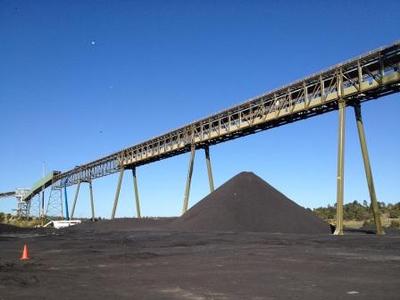Coal conveyor with lower environmental impact
Monday, 02 December, 2013
The Ellton Group has completed the construction of a 2 km coal conveyor system for Rio Tinto Coal Australia’s Coal and Allied Hunter Valley Operations.
The 1400 mm belt conveyor system rated at 2400 TH includes an overland conveyor and a skyline stacker conveyor system that eliminates the previous need for heavy trucks to transfer coal from another load-out facility during peak production.
The conveyor design also overcomes numerous environmental and structural challenges as it traverses reclaimed and subsidence-prone land to deliver high volumes of coal to an existing stockpile facility through a cost-efficient design that incorporates recycled previous structures.

“One of the many unique aspects of the design was the complete incorporation of an existing skyline gantry system contained within the new structure,” said the Mark Elliott, Managing Director of the Ellton Group.
“The old gantry had a tripper running through it. We built our new, higher-capacity structure around the existing tripper gantry, running the conveyor in the opposite direction but sharing a radically improved and strengthened structure that easily and safely handles higher conveyor loadings but is designed to minimise additional mass and wind loadings.”
Working in consultation with Rio Tinto’s operations staff and their consultants, the Ellton Group developed various options that made good use of existing infrastructure while observing Rio’s safety and environmental standards.
“That’s the sort of thing you can do as a younger, nimble and innovative supplier. While we have had plenty of experience, particularly in the Hunter Valley, we are not bound to old ways of doing things or regimented thinking that says we have to tear down everything that’s already there and start again. As a company committed to efficiency, sustainability and minimising the impact on the environment, I think Rio Tinto were impressed by our close attention to their wishes”, explained Elliott.
The overland conveyor needed to pass above extensive areas of reclaimed and previously mined land that is prone to subsidence. Safe and efficient design of the trestle structures carrying the conveyor included trestle structures and roof sections that were not only structurally independent of each other, but also independently adjustable in three dimensions.
Maximum use of existing infrastructure was a prime objective. However, wanting to incorporate existing structures in the final design that were not originally rated for the revised duty, was only part of the design challenge. The upgrade works had to occur while the existing plant continued to operate so the new design had to be suitable for construction in and around equipment that could not be stopped or demolished.
Minimised additional wind and mass loading on the existing structure was achieved by adopting a ‘wrap-around’ gantry design to support the new conveyor and tripper. The gantry design had to be as light as possible and still allow the existing tripper to operate inside the old gantry both during and following construction.
Rio Tinto also had extensive requirements for containment and protection of the load and the surrounding environment. In addition to full coverage of the conveyed load to minimise spillage and dust, the areas traversed by the overland conveyor are protected by civil works including bunding, side dish drains, channelling and settlement ponds. These works separate and redirect clean water run-off from the surrounding landscape to avoid possible contamination, and capture water emanating from the conveyor path and direct it to one of several dirty-water settlement ponds constructed along the route. By containing run-off and run-on, recycling is optimised and contamination of the environment is avoided.
Ellton Group also re-used old gantry structures, which were stripped, refurbished, painted and refitted to new standards and incorporated into the elevated stages of the overland conveyor. The fully enclosed tipper feed structure now also spans a busy local road, removing the need for trucking by providing a clean and safe alternative.
Bonfiglioli Power Pack heavy-duty, fully coupled drive combinations were used.
“The drives were specified by Bonfiglioli Business Development Manager Kris Jaryn with whom we have worked well before,” said Elliott. “Bonfiglioli is a respected supplier that gave us what we needed when we needed it, to provide on-time performance.” The drives and take-ups were mounted at ground level, rather than with elevated drives and vertical take-ups, for ease and safety of maintenance. “A problem with off-ground mounting is that access is difficult and it is hard to isolate the belt and remove the energy load from within it,” explained Elliott.
“With our on-ground concept, it is simple and safe to de-tension the belt and remove the stored energy, thus enhancing safety. The hazards associated with isolating suspended gravity weights are removed. The design - which reflects our experience in underground mining - also provides better and quicker access for maintenance,” said Elliott.
Women in automation: Ella Shakeri
On International Women's Day 2024, Swisslog System Design Engineer Ella Shakeri is...
Keeping manufacturing and distribution on track
RFID systems can help revolutionise the way a business tracks goods and manages inventory.
Tracking software for pallets, containers and more
Pallets, crates, containers, racks and tanks often remain unattended in warehouses for days,...














